
| next curve | previous curve | 2D curves | 3D curves | surfaces | fractals | polyhedra |
SELF-PARALLEL CURVE, CURVE OF CONSTANT WIDTH
| Curves studied by Euler in 1778 and Reuleaux in 1875.
Other name: orbiform curve (name given by Euler; orbis = circle in Latin). See this page by Alain Esculier for explanations on the figures. See also this article by Marc Roux on inflatable sets. T. Bayen, J.-B. Hiriart-Urruty Objets convexes de largeur constante (en 2D) ou d’épaisseur constante (en 3D) : du neuf avec du vieux. |
1) Self-parallel curves.
A self-parallel curve is a connected curve parallel to itself (at nonzero distance); a connected curve is self-parallel if and only if it is the common trajectories of both the ends of a line segment not reduced to a point, each point of which has a speed vector orthogonal to the segment line.
Examples:
- the circle is parallel to itself with a parallelism distance equal to its diameter.
- the involutes of a closed curve with cusps are self-parallel, with a parallelism distance equal to the length of the closed curve; the simplest example is the involute of a circle:

- consider a closed curve (G) with, in that order, cuspidal points . Let
be the length of the arc
and
;
If n is even and , the involutes of (G) are self-parallel with a parallelism distance equal to
.
If n is odd and the abscissa a of the initial point of the involute when the tangent is at is different from
, then the involutes of (G) are self-parallel with a parallelism distance equal to
; furthermore, they are also closed curves.
In particular, the involutes of epi- and hypocycloids with an odd number of cusps are self-parallel (except one that is similar to the initial curve):
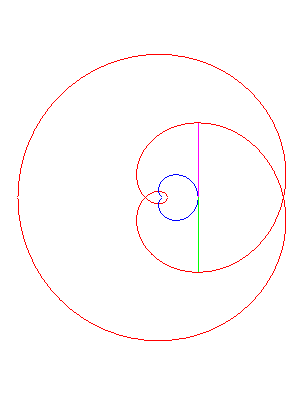 |
Closed self-parallel curve, evolute of a cardioid.
Note the change of orientation of the segment line after one turn. |
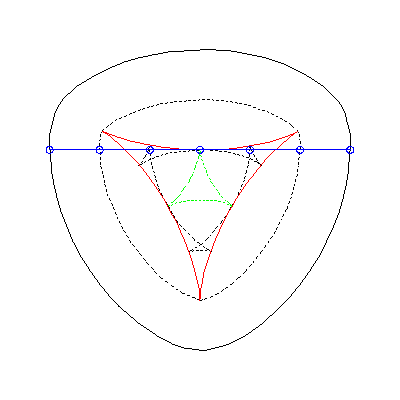 |
Involutes of the deltoid; only the green involute is not self-parallel. |
| With a segment line of length greater than that of an arch of the deltoid: the curve is convex |
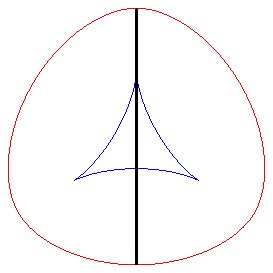 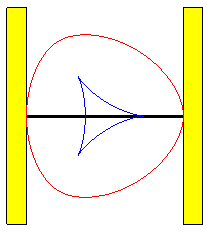 |
| With a segment line of equal length: limit case of a convex curve; there are three points with infinite curvature. |
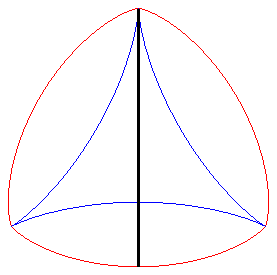 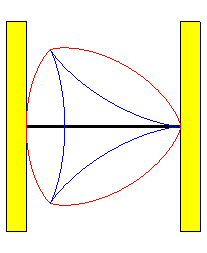 |
| With a segment line of smaller length: the curve has six cuspidal points.
The limit case of the segment line of length zero gives the only involute of the deltoid that is not self-parallel: the deltoid itself. 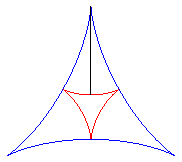 |
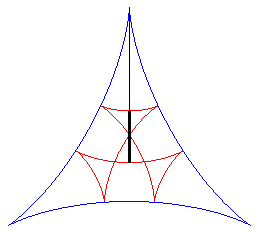 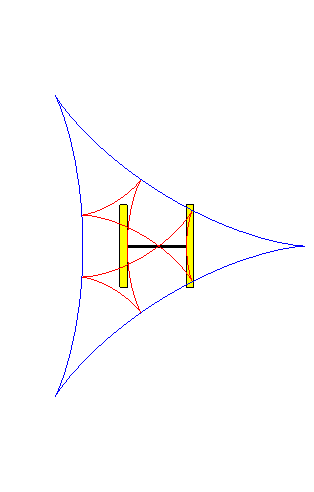 |
With an epicycloid with 7 cusps:
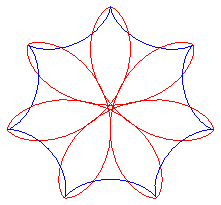 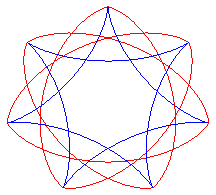 |
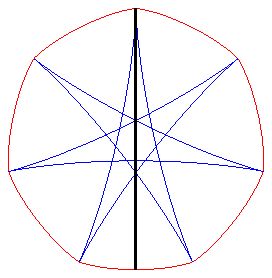 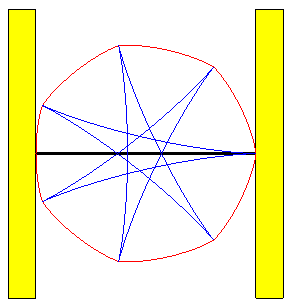 |
| Is it precisely this curve that was chosen as the outline for 20 and 50 pence coins?
It is at least, certainly, a curve of constant width (see later) because these coins are to function in vending machines (whatever their orientation, they must pass through an aperture of given diameter): an exact heptagon would have been a problem! |
  |
| Complex parametrization of the involute of the hypocycloid for a segment line of length equal to an arch: See also the bottom of the page dedicated to the hypocycloids |
2) Curve of constant width.
Given a convex compact subset K of the plane, its width in the direction D is defined as the length of the orthogonal projection of K on D, length which also is the smallest width of a strip orthogonal to D and containing K, or, which amounts to the same thing, as the distance between two supporting lines of the convex set K, orthogonal to D.
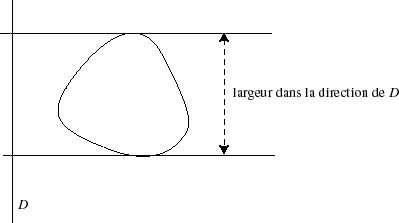
The convex set K is then said to be "of constant width" if this width does not depend on the direction D and a curve is said to be "of constant width" if it is the boundary of a compact convex set if constant width. Another way of defining the fact that K has constant width is that it can be turned continuously by a half-turn inside a closed strip in such a way that the two boundaries of the strip always remain in contact with K (see the animations above).
Therefore, the following remarkable equivalent statements define a convex compact set of constant width:
 |
1) K is convex and compact and the lengths of all the projections of K on a line are all equal to d.
2) K is convex and compact and the infimum of the widths of the closed strips in a given direction containing K is d. 3) K is convex and compact and two distinct and parallel supporting lines are at distance d from one another. 4) K is convex and compact with diameter d and two distinct and parallel supporting lines D1 and D2 are always such that there exist A1 in KÇD1 and A2 in KÇD2 with (A1 A2) orthogonal to D1. 5) K is convex and compact and the supremum of the lengths of segment line of given direction included in K is d. 6) K is convex of diameter d and there always exists a segment line of given direction and length d included in K. 7) K is convex and the set of the vectors 8) K has diameter d and is maximal for inclusion among the parts with diameter d. |
The link with 1) comes from the fact that any convex (i.e. boundary of a convex compact set) self-parallel curve (with parallelism distance d) is a curve of constant width d; see the examples given above.
The first discovery of an example of a curve of constant width that was not circular was the Reuleaux triangle, or equilateral orbiform:  composed of three arcs of circles centred on the vertices of an equilateral triangle (continuous curve, but with three sharp points, as opposed to the examples above), example that can be generalised to any regular polygon.
composed of three arcs of circles centred on the vertices of an equilateral triangle (continuous curve, but with three sharp points, as opposed to the examples above), example that can be generalised to any regular polygon.
See also an example based on the toroid.
All the curves of constant width equal to d have the same length, equal to pd (Barbier theorem), and the area of the delimited domain is minimal in the case of the Reuleaux triangle - minimum equal to
(Blaschke-Lebesgue theorem), and maximal in the case of the circle - maximum equal to... I am sure you know!
Any bounded part of the plane is included in a convex of constant width equal to the width of the initial set.
See also the surfaces of constant width.
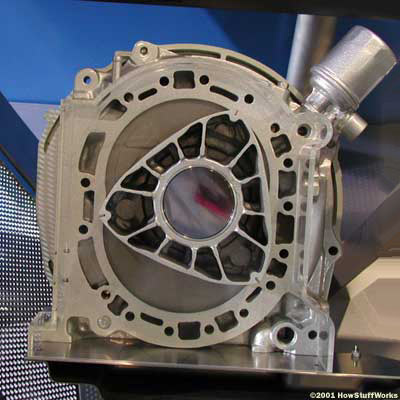
| next curve | previous curve | 2D curves | 3D curves | surfaces | fractals | polyhedra |
© Robert FERRÉOL , Samuel BOUREAU, Alain ESCULIER, 2017